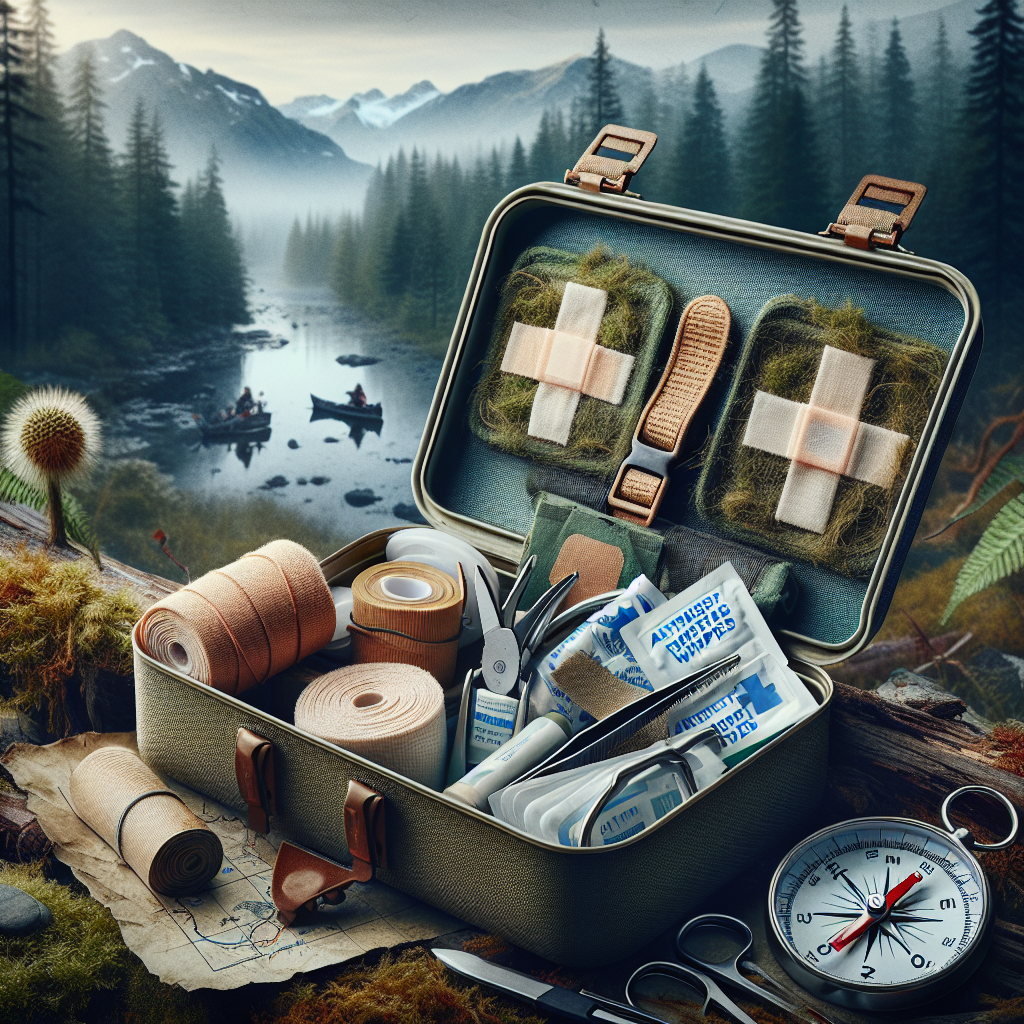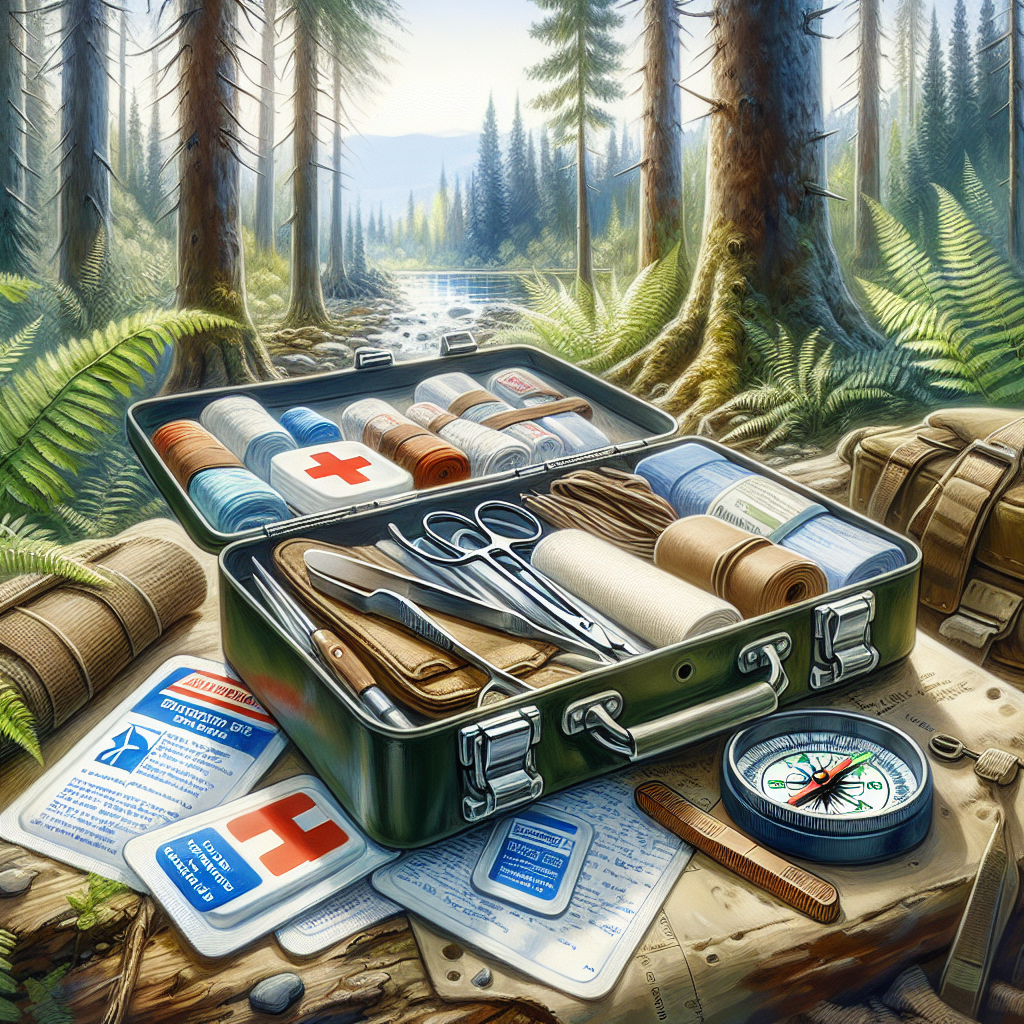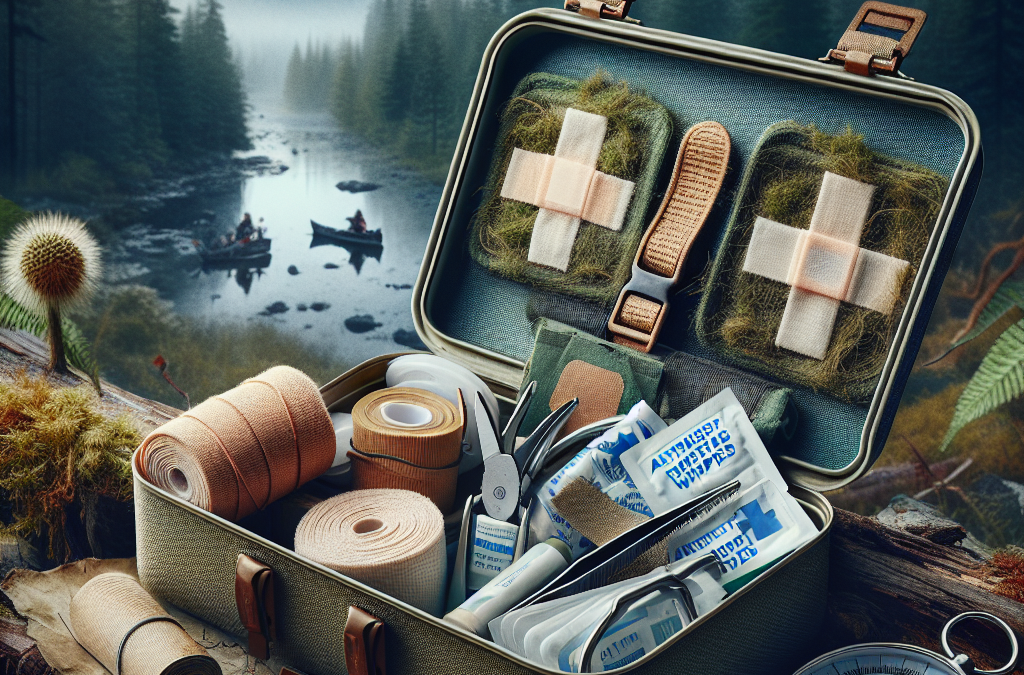Imagine you’re out hiking, far from the hustle and bustle of daily life, when suddenly, an unexpected incident occurs. Without any immediate help nearby, what should you do? “The Essential Guide to Outdoor First Aid” is here to equip you with critical knowledge and skills needed when emergency medical help is not readily available. Learn about preventive measures, treatment techniques, and aftercare for outdoor-related injuries and accidents. This handy guide could prove life-saving, transforming your outdoor explorations into safe and worry-free adventures. Whether you’re a nature novice or seasoned adventurer, this guide is a must-have companion for your outdoor escapades.

Understanding the Importance of Outdoor First Aid
The great outdoors can be a source of peace, tranquility, and adventure, but they are also unpredictable and can sometimes present challenges. It’s important to be prepared for potential injuries or medical emergencies that may arise during these adventures so that they can be dealt with swiftly and effectively. This is where outdoor first aid comes in.
Defining the role of first aid in outdoor activities
First aid plays an essential role in outdoor activities as it enables individuals to respond immediately to injuries or illnesses that may occur. This prompt action can mean the difference between a minor setback and a life-threatening situation. By having a thorough knowledge of first aid, you’re taking responsibility not just for your personal safety, but the wellbeing of your companions as well.
Highlight on the differences between indoor and outdoor first aid
While many of the core principles of first aid remain the same, indoor and outdoor environments present different challenges. Outdoor activities may take you far away from medical facilities. As such, the emphasis is often on stabilization and removal from danger until professional help can be sought. Outdoor first aid also covers unique situations, like managing injuries sustained in extreme weather, which would rarely be encountered indoors.
Real-life instances where outdoor first aid has been crucial
Imagine you’re hiking in a remote area and a companion slips, injuring their ankle. Without the ability to walk, the injury, though minor itself, can become life-threatening very quickly due to vulnerability to elements and potential dehydration. Here, with sufficient knowledge of outdoor first aid, you’d be able to stabilize the injury and arrange for evacuation. In another instance, a fellow kayaker capsizes in cold water and starts showing signs of hypothermia. Knowing the first aid treatment for hypothermia could save a life right then and there.
Essential Tools for Outdoor First Aid
Just as vital as first aid knowledge is having the right tools on hand when you need them. In the outdoors, a comprehensive first aid kit should always be part of your equipment.
Outline of a standard outdoor first aid kit
A standard outdoor first aid kit should include items to handle a range of injuries or illnesses. This includes bandages, antiseptics, a CPR mask, a space blanket for warmth, and medications for common ailments like pain, allergies, and stomach troubles. Keep in mind that you might encounter more severe injuries, so tools like splinting material and a tourniquet are helpful too.
Description of specific items in an outdoor first aid kit
Starting with bandages, these are essential for covering wounds and preventing infection. Antiseptics are used to clean wounds before dressing. A CPR mask allows you to perform this potentially life-saving procedure safely. For those colder environments, a space blanket can help prevent hypothermia. Medications for pain relief, allergies, and stomach problems can transform a miserable situation into a manageable one.
Advice on choosing a pre-assembled first aid kit vs. assembling your own
You can purchase pre-assembled outdoor first aid kits, which are a convenient choice, especially for beginners. They contain the basics you’ll need and are usually packaged in a compact, organized way. But if you’re a more seasoned adventurer, you might prefer to assemble your own kit. This allows you to tailor the contents to your specific needs and activities. Whether you choose a pre-assembled kit or curate your own, remember to replenish used items regularly.
Assessing an Emergency Situation
When you encounter a medical emergency in the outdoors, your first task is to assess the severity of the situation. It’s important to stay calm, collected, and to follow a structured assessment procedure.
Steps for determining the severity of an injury or illness
Determining the severity of an injury involves a careful observation of the injured individual and a series of questions to guide your response. Look for signs of severe pain, deformity, loss of function or feeling, bleeding, confusion, breathing difficulty, and changes in skin color. Asking about what happened can give crucial information.
Review of the acronym DRABC (Danger, Response, Airway, Breathing, Circulation)
The acronym DRABC is a memorable way to structure your response: Danger – ensure the area is safe for both you and the casualty; Response – check if the casualty is responding; Airway – make sure the casualty’s airway is clear; Breathing – check if they are breathing normally; and Circulation – confirm if they have a pulse. This sequence helps ensure the most critical aspects are addressed first.
Introduction to triage in outdoor settings
In events where there are multiple casualties, you may need to use triage, a way of prioritizing who needs help first. Those in the most immediate danger are treated first, followed by those who can survive with delayed treatment. It’s a tough process, but in extreme circumstances, it helps save the most lives possible.
Basic Outdoor First Aid Skills
In an outdoor emergency situation, there are practical skills that might be required including performing CPR, cleaning and dressing a wound, and immobilizing a broken bone.
Explanation of CPR and its importance
Cardiopulmonary Resuscitation or CPR is a life-saving technique used in emergencies where a person’s heart has stopped or they’ve stopped breathing. A combination of chest compressions and rescue breaths can help keep oxygen flowing to the brain and other vital organs until further treatment is available.
Guide on how to clean and dress a wound
Outdoor environments are full of bacteria, so cleaning and dressing a wound is a vital skill. First wash hands if possible. Rinse the wound with clean water and gently clean around the area with soap and a clean cloth, but don’t get soap in the wound. Apply an antibiotic ointment if available and cover the wound with a clean dressing.
Steps on how to immobilize a broken bone
If a bone is broken, the best thing you can do until medical help arrives is to immobilize it. This can be done with splints made from boards, sticks, or even magazines, held in place with cloth strips or bandages. Remember not to apply the splint on the injured area directly but instead support the joints above and below the break.

Dealing with Extreme Weather Conditions
The weather can be as much of a challenge as dealing with injuries when outdoors. From hypothermia and frostbite in freezing conditions to heat exhaustion and heat stroke when it’s hot, it’s important to be prepared.
Introduction to hypothermia and heat exhaustion
Hypothermia occurs when the body loses heat faster than it can produce, causing a dangerously low body temperature. Signs include exhaustion, shivering, slurred speech, and confusion. On the other end of the spectrum, heat exhaustion is caused by exposure to high temperatures, especially when combined with strenuous physical activity and inadequate fluid intake. Symptoms include heavy sweating, faintness, and muscle cramps.
Instructions on how to recognize and treat frostbite
Frostbite happens when skin and tissue freeze, often affecting areas like fingers, toes, ears, and noses. Skin may appear white or grayish-yellow, feel unusually firm or waxy, or be numb. To treat, warm up the area slowly; don’t rub the frostbitten area as this can cause more damage.
Guidance on managing heat stroke symptoms and prevention measures
Heat stroke, a severe form of heat illness, occurs when the body overheats and can’t cool down. This is a medical emergency characterized by body temperature above 104F, altered mental state, alteration in sweating, nausea and vomiting, flushed skin, rapid breathing, and racing heart rate. Cool the person quickly but safely and call for professional medical help immediately. Avoid heat stroke by staying well hydrated, avoiding midday sun, and listening to your body.
Handling Animal and Insect Bites and Stings
Many outdoor areas are home to wildlife that can bite or sting. Being prepared for these inevitabilities will help make your outdoor adventures more enjoyable and safe.
Common animal and insect bites and stings in outdoor settings
From mosquitoes, ticks, bees, and spiders to larger animals like snakes or mammals, there’s a range of critters to be aware of. Reactions can vary from minor irritation to serious allergic responses or diseases transmitted by the bite.
Steps to treat bites and stings
For insect stings, first, ensure that the stinger is removed, then clean the area with water and soap. Applying a cold pack can reduce swelling. For animal bites, if possible, clean the wound with warm water and soap, apply an antibiotic cream and a clean bandage. Big animal bites or any bite that causes serious bleeding, redness, pain, or swelling should be checked by a doctor as soon as possible.
Preventive actions against animal and insect bites and stings
Preventive measures include wearing suitable protective clothing, applying insect repellent, avoiding areas known to be home to venomous animals, shaking out shoes and clothing before wearing, and being careful where you place your hands or feet in areas you can’t see into.
Managing Dehydration and Nutrition
Physical activity, especially when it’s hot, can lead to dehydration if you’re not careful. On top of that, maintaining good nutrition is important for energy and recovery when undertaking outdoor activities.
Discussion on the importance of hydration and nutrition
Staying properly hydrated helps your body function at its best while promoting good health. Dehydration can lead to fatigue, dizziness, confusion, and even more severe health problems. Similarly, good nutrition provides the fuel you need for physical activities and supports overall health.
Tips for recognizing symptoms of dehydration
Symptoms of dehydration can vary but common ones include thirst, less frequent urinating, dark-colored urine, fatigue, dizziness, and confusion. Drinking plenty of water and sports drinks, especially during hot weather or demanding activities, can help prevent dehydration. It’s prudent to always carry adequate water supplies during outdoor activities.
Advice on how to ensure sufficient nutritional intake outdoors
Proper nutrition can make a big difference especially on challenging adventures. Pack meals and snacks that are high in energy and filled with a balance of nutrients – think complex carbohydrates, proteins, healthy fats, and of course, fruits and veggies where possible.
Training for Outdoor First Aid
Knowledge and skills in outdoor first aid can make a world of difference in your outdoor adventures. Luckily, there are plenty of training options available for outdoor enthusiasts of all levels.
Overview of certification programs and courses
There are numerous certification programs and courses that provide targeted training in outdoor first aids, such as those offered by outdoor retailer organizations, wilderness medicine institutes, and the Red Cross. These courses teach you how to respond to different types of injury, illness, and emergency situations in the outdoors.
Benefits of hands-on training
While you can learn a lot from books and online resources, there’s nothing quite like hands-on training. This helps you practice the skills and techniques in a controlled environment, so you can build confidence and be ready when a real emergency happens.
Highlights of content in a typical outdoor first aid course
In a typical outdoor first aid course, you can expect to learn about assessing an injury or illness, providing basic care, managing weather-related ailments, dealing with animal and insect bites and stings, recognizing signs of dehydration, and understanding the principles of evacuation, among other topics.
Mental Preparedness for Emergency Situations
In an emergency situation, one of the most important yet often overlooked factors is mental preparedness. Being mentally ready to handle an emergency helps you stay focused, make good decisions, and reassure others in the situation.
Discussion on the importance of staying calm
When an emergency occurs, it’s natural to panic, but keeping calm is critical. By staying calm, you’re more likely to think clearly, make good decisions, and provide appropriate care. It’s also reassuring to the injured person and others present.
Techniques for managing stress and anxiety in emergencies
Breathing exercises can help manage stress and anxiety, as can mindfulness and meditation techniques. Regular practice of these techniques can help condition your mind to better cope in an emergency situation.
Importance of mental rehearsal and scenario planning
Mental rehearsal – picturing yourself handling emergency scenarios – is a strategy that can aid in actual unplanned emergencies. If you’ve considered possibilities and ‘practiced’ your responses ahead of time, you’re likely to be more prepared and less flustered if they occur.
Legal and Ethical Considerations of Outdoor First Aid
Individuals providing first aid need to be aware not only of the physical implications but also the legal and ethical considerations.
Outline of the Good Samaritan laws
Good Samaritan laws grant legal protection to people who give reasonable assistance to those who are injured, ill, in peril, or otherwise incapacitated. These laws vary but are designed to reduce bystander hesitation to assist due to fear of being sued for unintentional injury or wrongful death.
Discussion on Informed Consent in Emergency Situations
In emergency situations, if the person is conscious, informed consent is required before providing first aid. It involves explaining what you intend to do and why, and getting the person’s permission to proceed.
Thoughts on the moral responsibility of outdoor adventurers to have first aid knowledge and skills
While not legally required, it’s arguably a moral imperative that anyone participating in outdoor activities should have a basic knowledge of first aid. This responsibility to oneself and to others can prevent minor injuries from becoming severe, reduce pain and discomfort, and potentially save lives.

